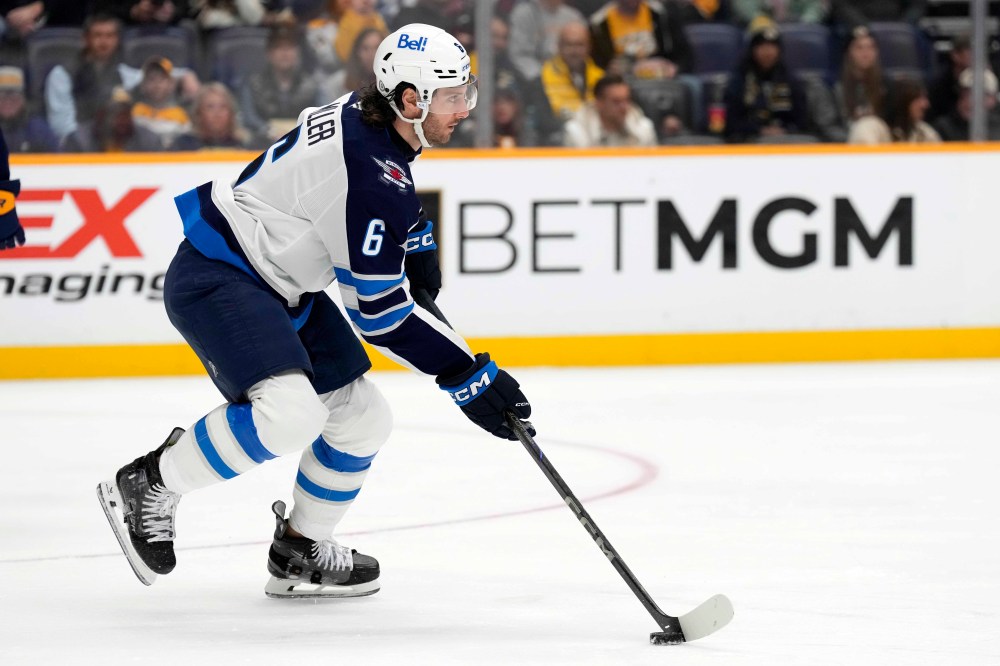Jets’ Miller recovering from fractured larynx; NHLers remain slow to adopt neck protectors
Read this article for free:
or
Already have an account? Log in here »
To continue reading, please subscribe:
Monthly Digital Subscription
$0 for the first 4 weeks*
- Enjoy unlimited reading on winnipegfreepress.com
- Read the E-Edition, our digital replica newspaper
- Access News Break, our award-winning app
- Play interactive puzzles
*No charge for 4 weeks then price increases to the regular rate of $19.00 plus GST every four weeks. Offer available to new and qualified returning subscribers only. Cancel any time.
Monthly Digital Subscription
$4.75/week*
- Enjoy unlimited reading on winnipegfreepress.com
- Read the E-Edition, our digital replica newspaper
- Access News Break, our award-winning app
- Play interactive puzzles
*Billed as $19 plus GST every four weeks. Cancel any time.
To continue reading, please subscribe:
Add Free Press access to your Brandon Sun subscription for only an additional
$1 for the first 4 weeks*
*Your next subscription payment will increase by $1.00 and you will be charged $16.99 plus GST for four weeks. After four weeks, your payment will increase to $23.99 plus GST every four weeks.
Read unlimited articles for free today:
or
Already have an account? Log in here »
Hey there, time traveller!
This article was published 07/01/2025 (323 days ago), so information in it may no longer be current.
Hockey’s latest scary neck injury is hitting home for the Winnipeg Jets. Just don’t hold your breath on it changing anything when it comes to player safety.
Veteran defenceman Colin Miller suffered a fractured larynx last Saturday night after getting struck in the throat with a deflected shot during a game against the Detroit Red Wings at Canada Life Centre.
“A dangerous situation,” is how Jets head coach Scott Arniel described it Tuesday.
Miller, 32, was able to skate off the ice under his own steam but then went down in the tunnel behind the players’ bench as team training staff rushed to his aid. There was immediate concern about his airway swelling up.
Fortunately, Miller never lost consciousness and is now on the road to recovery after getting checked out in hospital and seeing a specialist.
MARK HUMPHREY / THE ASSOCIATED PRESS FILES Colin Miller suffered a fractured larynx last Saturday night after getting struck in the throat with a deflected puck.
“He’s doing a lot better,” said Arniel, noting Miller was able to ride a stationary bike while his teammates skated before facing the Nashville Predators.
“He’s around the guys. Talks a little quieter. But at the end of the day, he’s upbeat. Just the biggest thing, it’s precaution now. It has to heal.”
Miller, who has eight points (2G, 6A) in 34 games with the Jets this season, is expected to miss at least two weeks.
“You never want to see that,” said Miller’s teammate and friend, Dylan Coghlan, who took his spot in the lineup. “We were worried about him, but he’s in good spirits.”
There have been several similar incidents this season, including one involving the Jets last month. Captain Adam Lowry took a wrist shot that Chicago Blackhawks defenceman Alec Martinez deflected into his own throat during a Dec. 7 game. He has yet to return to the lineup.
Coghlan, who was previously teammates with Martinez in Las Vegas, also noted St. Louis Blues forward Dylan Holloway had to be taken off the ice on a stretcher after being hit in the neck by a deflected shot in early November. Holloway was fortunate in that the puck only struck a nerve and didn’t cause any other damage.
“You never want to see anybody leave the game like that,” said Coghlan.
You’d think, given the recent close calls, players would be lining up to don protective gear that might help prevent future incidents.
You’d be wrong.
According to the NHL, only 7.7 per cent of players are wearing neck guards this season despite the fact former NHLer Adam Johnson died in 2023 after suffering a skate cut to the throat during a pro game in England.
Numerous leagues made the protective equipment mandatory following the tragedy, including the English Ice Hockey Association, the Western Hockey League, the Canadian Junior Hockey League, the IIHF, USA Hockey and, last fall, the ECHL and American Hockey League.
However, the NHL has opted to leave the decision to individual players. Only 55 skaters are currently taking the initiative. There were many more in the weeks following Johnson’s death, including several on the Jets where the tragedy resonated deeply considering defenceman Neal Pionk was his best friend.
It appears Pionk is one of the only players still wearing one.
“I’ve kind of seen it evolve through the no-helmet thing, visors,” Arniel told the Free Press on Tuesday when asked where he stands on the issue.
“Now, the situations that have happened over the last couple of years with the cuts. Just the socks, wrist bands, the gloves, all of these things that are changing. I don’t have a problem with it. Someday it’s probably going to be just a standard part of the equipment.”
Perhaps, but expect pushback from players. According to a poll of 181 NHL regulars conducted by The Athletic last year, 78 per cent stated they don’t want the league to mandate neck guards. Comfort is cited as the primary reason, even though technology has evolved to make them lighter and cooler than ever.
“Someday it’s probably going to be just a standard part of the equipment.”–Head coach Scott Arniel
“At the end of the day, with players wearing visors, it’s taken a while and now it’s pretty much almost all there. I don’t think it’s going to be any different with the neck guard,” Arniel predicted.
Although absorbing a sharp blade would be the primary benefit of a neck guard, softening the blow of a speeding puck certainly couldn’t hurt.
One of the worst-case scenarios happened during a January 2000 game in which Montreal Canadiens forward Trent McLeary was hit with a slapshot from Philadelphia Flyers defenceman Chris Therien. McLeary required an immediate tracheotomy at the rink to save his life.
Now, 25 years later, players are shooting the puck harder than ever, which would seem to be increasing the risk.
Hockey is a game filled with danger, and a look at Winnipeg’s current injury list is a vivid reminder: Dylan Samberg is out with a broken foot, while Haydn Fleury and Mason Appleton are sidelined with hurts as well. But there’s a big difference between something that might knock you out of the lineup for a few weeks, and something that might end your life.
“I’ve seen some scary things over my years,” said Arniel, who was on the Buffalo Sabres in 1989 when goaltender Clint Malarchuk nearly bled to death after suffering a skate cut to his neck.
But the former player-turned-coach has also seen the marvels of prompt medical care, including how Jets trainers rushed to Miller’s aid on Saturday night.
“Having people in place that are ready to react to that, there’s a lot of things that have gone on in this game. Whether it’s our sport or football or some other sports, when you have those people in place that are ready to react — for the players, it certainly is comforting and you never take them for granted,” he said.
“These guys, they are specialists at what they do. We’re special at what we do, the players are — and then, those guys have something that is extremely important for us.”
mike.mcintyre@freepress.mb.ca
X and Bluesky: @mikemcintyrewpg

Mike McIntyre is a sports reporter whose primary role is covering the Winnipeg Jets. After graduating from the Creative Communications program at Red River College in 1995, he spent two years gaining experience at the Winnipeg Sun before joining the Free Press in 1997, where he served on the crime and justice beat until 2016. Read more about Mike.
Every piece of reporting Mike produces is reviewed by an editing team before it is posted online or published in print — part of the Free Press‘s tradition, since 1872, of producing reliable independent journalism. Read more about Free Press’s history and mandate, and learn how our newsroom operates.
Our newsroom depends on a growing audience of readers to power our journalism. If you are not a paid reader, please consider becoming a subscriber.
Our newsroom depends on its audience of readers to power our journalism. Thank you for your support.
History
Updated on Tuesday, January 7, 2025 4:18 PM CST: Corrects spelling of Fleury's first name







